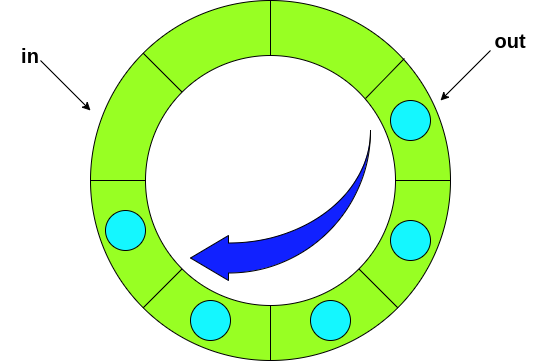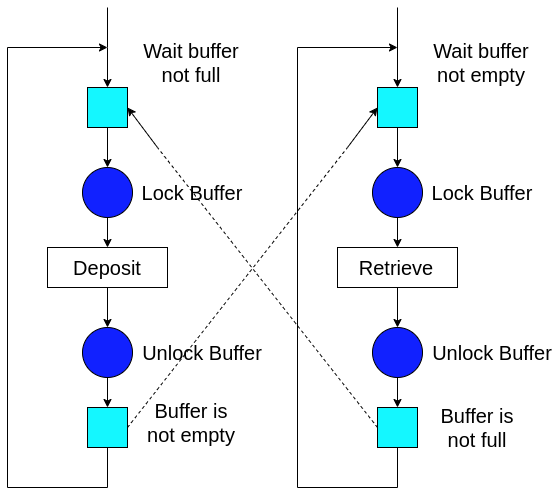Bounded Buffer & Producer-Consumer
Introduction
The Bounded Buffer Problem is a classical synchronization problem in operating systems that models the interaction between producers and consumers sharing a fixed-size buffer.
This problem represents a real-world scenario where data is produced and consumed concurrently, requiring proper coordination to avoid issues like data corruption, buffer overflow, and starvation.
A virtual lab simulation of the bounded buffer problem helps students understand the challenges of concurrent programming and the importance of synchronization mechanisms in ensuring data consistency and system stability.
Example of Bounded Buffer Problem in an Operating System to Illustrate the Problem
Let’s consider a scenario where two processes—a producer and a consumer—are sharing a common memory buffer without any synchronization mechanisms like semaphores or mutexes. This example highlights the problems that can arise due to the lack of proper coordination:
Scenario
- A text editor (producer) writes characters into a shared buffer.
- A spell checker (consumer) reads characters from the buffer to check for spelling errors.
- The buffer size is fixed at 5 characters.
Initial State
- The buffer is empty.
- The producer starts generating characters and placing them into the buffer.
- The consumer starts reading and processing characters from the buffer.
Potential Unsafe Scenarios
1. Race Condition
- If the producer and consumer try to access the buffer at the same time, they could corrupt the data.
- Example:
The producer writes"HELLO"into the buffer, but before it finishes, the consumer starts reading and only gets"HE"because the producer was interrupted halfway.
2. Overwriting Data (Lost Update Problem)
- If the producer is faster than the consumer, it could overwrite data before the consumer has a chance to process it.
- Example:
- Producer writes
"HELLO"→ Consumer starts reading"HE". - Producer writes
"WORLD"before the consumer finishes → Consumer reads"HEWOR"(corrupted output).
- Producer writes
3. Buffer Overflow
- If the producer keeps adding data when the buffer is filled, it could result in a buffer overflow.
- Example:
- Buffer size = 5 → Producer tries to write
"HELLO"+"WORLD"→ Causes overflow, and some data is lost.
- Buffer size = 5 → Producer tries to write
4. Reading from an Empty Buffer
- If the consumer starts reading from the buffer while it's empty, it might receive garbage values or cause a crash.
- Example:
- Consumer expects data → Buffer is empty → Consumer reads uninitialized values.
5. Deadlock
- If both the producer and consumer reach a state where they are waiting for each other to act, the system can enter a deadlock.
- Example:
- Producer waits for space in the buffer to become available.
- Consumer waits for data to be added to the buffer.
- Neither can proceed, causing a permanent block.
Why We Need Semaphores or Mutexes
- Semaphores help regulate how many slots are available for the producer and consumer, preventing overflow and underflow.
- Mutexes ensure that only one process accesses the buffer at a time, preventing race conditions and data corruption.
- Proper synchronization mechanisms prevent these issues and maintain the integrity and consistency of the data exchange.
Conclusion
This example illustrates how the lack of synchronization causes unpredictable and inconsistent behavior, which is exactly why the Bounded Buffer Problem needs to be solved with semaphores and mutexes.
How We Solve the Bounded Buffer Problem
Suppose we have a circular buffer with two pointers
in→ Indicates the next available position for depositing data.out→ Indicates the position that contains the next data to be retrieved.
The diagram below represents the circular buffer concept:

Key Concepts
Shared Buffer Management
- The producer and consumer share a common memory area (the buffer).
- The size of the buffer determines how many data items can be held simultaneously.
Synchronization Mechanisms
To prevent race conditions, synchronization primitives like:
- Mutexes (mutual exclusion locks)
- Semaphores
- Condition Variables
are used to ensure:
- Producers do not write to a filled buffer.
- Consumers do not read from an empty buffer.
- Only one process accesses the critical section at a time.
States and Actions
The system has defined states:
- Ready
- Busy
- OK
And actions such as:
- Producing (
put()) - Consuming (
get())
These actions transition the system between different states.
Analysis
Since the buffer is shared by all threads, it must be protected to prevent race conditions.
This requires the use of a mutex lock or a binary semaphore.
Important Conditions
- A producer cannot deposit its data if the buffer is filled.
- A consumer cannot retrieve data if the buffer is empty.
- If the buffer is not filled, a producer can deposit its data.
- If the buffer is not empty, a consumer can retrieve a data item.
How It Works
A producer must:
- Wait until the buffer is not filled.
- Deposit its data.
- Notify consumers that the buffer is not empty.
A consumer must:
- Wait until the buffer is not empty.
- Retrieve a data item.
- Notify producers that the buffer is not filled.
Additionally:
- Before accessing the buffer, the producer/consumer must lock the buffer.
- After finishing, they must unlock the buffer.
Overall Flow
Below is the conceptual flow of the buffer access and synchronization:

Summary
To implement this solution, we need:
| Semaphore | Initial Value | Purpose |
|---|---|---|
| empty | Buffer Size | Blocks producers when buffer is filled. |
| filled | 0 | Blocks consumers when buffer is empty. |
| mutex | 1 | Guarantees mutual exclusion when accessing the buffer. |
Explanation of Initial Values
empty = Buffer Size
→ Initially, the buffer is empty, so we can allow that many producers to deposit.
Each deposit decreases the count by one. When filled,empty = 0, blocking producers.filled = 0
→ Buffer is initially empty, so consumers should not be allowed to retrieve.mutex = 1
→ A binary semaphore to ensure exclusive access to the buffer.
